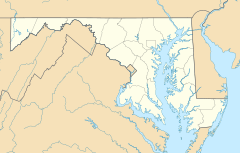Collington, Maryland facts for kids
Quick facts for kids
Collington
|
|
|---|---|
|
defunct settlement
|
|
| Country | |
| State | |
| County | |
| Time zone | UTC-5 (Eastern (EST)) |
| • Summer (DST) | UTC-4 (EDT) |
| GNIS feature ID | 597266 |
Collington was an old settlement in Prince George's County, Maryland. It existed way back in colonial times, when America was still a group of colonies. Today, the area where Collington used to be is now part of the city of Bowie.
Contents
Where Was Collington Located?
Collington was found at specific coordinates: 38°58'6" North and 76°45'35" West. This helps us pinpoint its exact spot on a map.
The area of Collington stretched quite a bit. It went from near the Holy Trinity Episcopal Church on MD 450 East. It also reached towards the famous Belair Mansion.
To the south, Collington extended to where MD 197, also known as Collington Road, meets US 301. It also went west past Church Road.
A Look Back: Collington's History
Originally, this settlement was called "Collington Hundreds." A "hundred" was an old way of dividing land in colonial times. Later, people just called it "Collington."
One of the first mentions of Collington was in 1696. It was listed as one of the six "Hundreds" in Prince George's County. This shows how important it was in the early days of Maryland.
Important Historic Buildings in Collington
Many important buildings were built in Collington over the years. They tell us a lot about the area's past.
In 1746, Samuel Ogle, who was the colonial governor of Maryland, built the Belair Mansion. He also built the Belair stables in Collington. This became his home and the famous Belair Stud Farm, known for its horses.
Around 1790, a man named Baruch Duckett built Fairview Plantation in Collington. Later, Oden Bowie, who became a governor of Maryland, was born at Fairview in 1826. He is also buried there.
The Holy Trinity Episcopal Church was established in Collington in 1836. It has been an important part of the community for a long time.
How People Traveled: Transportation
The southern part of Maryland Route 197 is still known as Collington Road today. This road helps connect different parts of the area.
In 1696, James Mullican was chosen as the first person to oversee roads in the Colony of Maryland. This was a very important job!
In 1715, a court ordered a road to be built from St. Barnabas' Church. This road would go through James Mullikin's land and lead to Collington Bridge. Another road was also ordered to connect Collington Bridge to James Ridgeley's cart road at the Patuxent River.
Governor's Bridge crosses the Patuxent River. Governor Samuel Ogle built this bridge in the mid-1700s. He used it to travel between his mansion in Collington and the state capital in Annapolis.
The Baltimore & Potomac Railroad Company also had a train station called Collington. It was on the Pope's Creek line, about 4 miles south of Bowie Station. Today, only a long railroad siding (a side track) remains of this old stop.
Collington's Unique Soil
Collington is known for its special soil. It has a fine sandy loam on the surface. This type of soil was excellent for farming.
In the early 1900s, almost 85% of the area was used for growing crops. Farmers grew corn, wheat, and tobacco. The rest of the land was covered by hardwood forests.
Below the topsoil, there are layers of yellowish-brown sandy clay and clay. These layers go down about 48 inches (122 cm).


